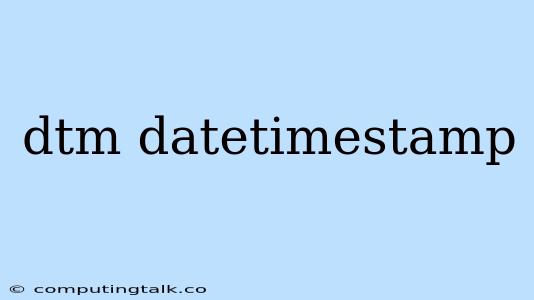Understanding dtm and datetimestamp in Data Management
In the realm of data management, accurate and consistent timekeeping is crucial. Precisely recording when an event occurred, data was updated, or a transaction was completed is essential for maintaining data integrity and enabling meaningful analysis. This is where the terms dtm and datetimestamp come into play, both representing ways to store and interpret time information within databases and applications.
What is dtm?
dtm is a common abbreviation used to represent a datetimestamp within various programming languages and database systems. It signifies a combined representation of both a date and a timestamp, providing a complete picture of when an event occurred. Essentially, it's a single value that encapsulates both the date and time of an event.
What is datetimestamp?
datetimestamp refers to the specific data type used to store dtm values. This data type is typically found in relational databases, where it's designed to hold information about both the date and time of an event with high precision. The exact format of a datetimestamp value might vary depending on the specific database system and its configuration, but it usually includes elements like year, month, day, hour, minute, second, and possibly even milliseconds.
Why use dtm or datetimestamp?
Using dtm or datetimestamp offers several advantages:
- Comprehensive Time Representation: Combining date and time into a single value provides a complete picture of when an event occurred, eliminating the need to manage separate date and time fields.
- Accurate Event Tracking: This approach ensures that all events are precisely timestamped, facilitating accurate event sequencing and analysis.
- Data Consistency: Using a standardized data type for time information promotes data consistency across various database tables and applications.
- Efficient Analysis: Combining date and time in a single value simplifies data analysis, allowing you to easily query, filter, and sort data based on specific time periods.
Example of Using dtm
Consider an e-commerce platform that tracks customer orders. Each order record could include a dtm field to store the time the order was placed. This would allow the platform to easily track the following:
- Order Processing Time: Calculate the time between order placement and shipment.
- Sales Trends: Analyze order volume over specific time periods.
- Customer Behavior: Identify customer ordering patterns and preferences.
What about other time formats?
While dtm or datetimestamp are widely used for storing time information, other data types might be used depending on the specific requirements:
- Date: Only stores the date portion, suitable for applications where time is not critical.
- Time: Stores only the time portion, useful for tracking time-sensitive events within a single day.
- Unix Timestamp: Represents time as a single integer representing the number of seconds since the Unix epoch (January 1, 1970).
Considerations for using dtm
- Timezone Awareness: Ensure your application correctly handles time zones to avoid inconsistencies when data is stored or retrieved from different locations.
- Database System Compatibility: Verify the specific data type and format supported by your chosen database system.
- Precision: Consider the required precision of time information. Some applications may require millisecond or even microsecond precision, while others may only need second-level precision.
Conclusion
dtm and datetimestamp are essential tools for managing time-sensitive data in various applications and databases. By accurately capturing both date and time information, you ensure data integrity, facilitate efficient analysis, and gain valuable insights into data trends and patterns. Remember to choose the appropriate data type based on your application requirements and ensure correct timezone handling for seamless data management.
